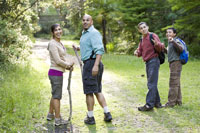
So many things can get between our intentions and our actions. Sometimes my desire to write—even when motivated by a firm deadline—is held at bay while I adjust the blinds, make tea, boot up and log on. Things I know I should do but haven’t fully bought into can find no end of delays and reasons not to.
So it is with exercise, for many people. But even those who know how good it feels to be physically active and who earnestly seek the health benefits of a healthy lifestyle may confront circumstances that make it inordinately difficult. I’d like to explore some of those challenges and ways to address them. The goal, as always, is to help everyone enjoy appropriate physical activity throughout the lifespan.
Perhaps you grew up in a suburban house with a generous backyard. Did you have a city park nearby? I did, and I loved to ride my bike to school—all over town, in fact, as my age and my parents’ confidence in me increased. Add schoolyard play and team sports, and I burned quite a few calories with a smile on my face. Many evenings saw robust games of Kick the Can at locations throughout the neighborhood.
What about kids who have no backyard, no nearby park and inadequate school playgrounds? Team sports aren’t an option for some, with no school leagues and no minivan to the soccer field.
Opportunities for adults vary, too. Not everyone can afford to join a health club and hire a personal trainer. Rural dwellers may live miles from the nearest facility. Membership or league fees are the barrier for some—ditto the cost of sports equipment, lessons and travel. Kids in unsafe neighborhoods may be kept indoors, snacking in front of the TV or game console.
Too often, such challenges get between healthful exercise and those who could benefit from it.
Solutions
Those who advocate for health and wellness can do much to expand opportunities for physical activity and exercise. Solutions may involve working with local officials or simple, informal collaboration. For example, can school facilities be open to the community after hours? How about pitching in to make a vacant lot into a pocket park? Neighbors, merchants and volunteers can work wonders in a day. A congregation in search of an outreach project might start a soccer league, a weekly game of kickball, or a jump-rope-a-thon.
For longer-term, larger-scale solutions, look at the impact rails-to-trails projects have had in some communities. Build paths and they will come: walking, wheeling, strolling and skating their way to fitness. Zoning laws can require sidewalks in new or redeveloped neighborhoods.
While some pursuits need costly equipment (think polo, on the high end), an active life often requires nothing more than a pair of walking shoes and your imagination.
Bottom line? Being physically active is too important to health and quality of life to let some of us go without. Let’s look at what keeps people from exercise and find ways to surmount the barriers. Now, what was I saying about writer’s block?
What barriers to physical activity confront some people in your community? How can they be overcome?





